Canadians will vote on Monday to elect the country’s 44th Parliament after a campaign that has seen Prime Minister Justin Trudeau‘s Liberal Party in a tight race against the opposition Conservatives.
More than 27 million people are eligible to vote, according to Elections Canada, which reported this week that approximately 5.78 million ballots have been cast in advance polls.
On election day, the polls open and close at staggered times across Canada, which stretches across several time zones. The last polls close on the country’s west coast at 7pm local time (02:00 GMT).
Election officials say the final results could be delayed in some close races as mail-in ballots, expected to number in the hundreds of thousands, are counted.
Here’s all you need to know about the Canadian electoral system, the key issues at the heart of this year’s campaign, who Canada’s main party leaders are, and what they have promised.
The system
Canada is a parliamentary democracy.
Monday’s vote will decide the 338 seats in the House of Commons, the lower house of parliament.
To achieve a majority government, a party needs to secure 170 seats.
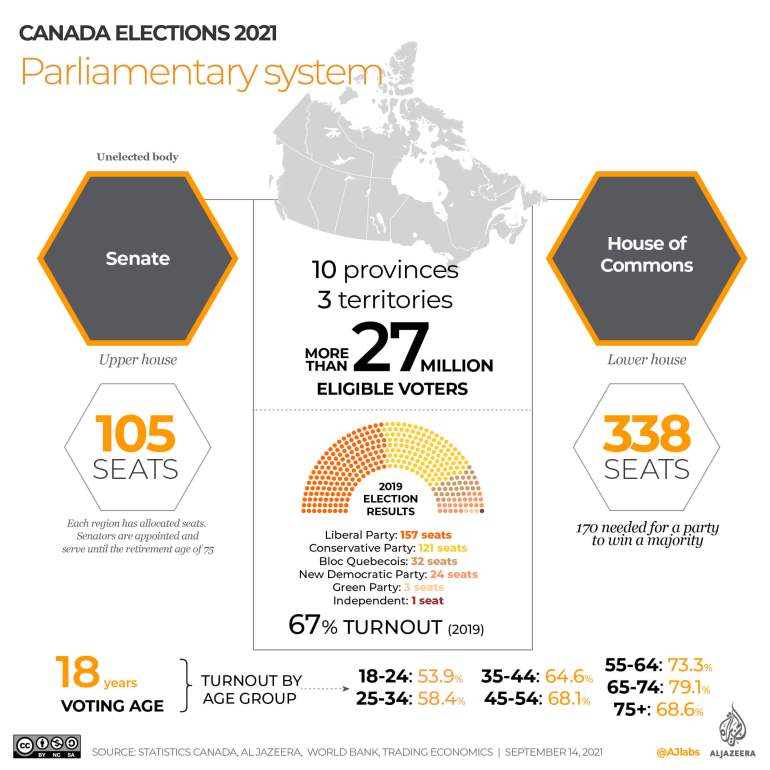 To win a majority, a party must get 170 seats in the House of Commons [Alia Chughtai/Al Jazeera]
To win a majority, a party must get 170 seats in the House of Commons [Alia Chughtai/Al Jazeera]Key issues
The federal election campaign comes amid the COVID-19 pandemic.
Canada has reported more than 1.56 million cases and more than 27,300 coronavirus-related deaths to date, according to Johns Hopkins University data.
In addition to the pandemic, the economy, housing, the climate crisis and health care are some of the critical issues on the minds of Canadians ahead of Monday’s vote.
 COVID-19, the economy, housing, the climate crisis and health care are some of the critical issues on the minds of Canadians [Alia Chughtai/Al Jazeera]
COVID-19, the economy, housing, the climate crisis and health care are some of the critical issues on the minds of Canadians [Alia Chughtai/Al Jazeera]Poll numbers
The Liberals, headed by Trudeau, and the Conservative Party, led by Erin O’Toole, have been neck-and-neck throughout the campaign, each polling at about the 31 to 32-percent mark. But the Liberals are projected to secure more seats in parliament than the Conservatives.
Jagmeet Singh’s New Democratic Party has come in third with about 20-percent support.
Here’s how the parties stacked up as of September 19:
 The Liberals and Conservatives have been in a tight race [Alia Chughtai/Al Jazeera]
The Liberals and Conservatives have been in a tight race [Alia Chughtai/Al Jazeera]Liberal Party
Trudeau has faced criticism for calling an election two years ahead of schedule, but he defended the decision by saying he wanted Canadians to have a say in how the country recovers from the COVID-19 pandemic.
But the Liberal leader has been met by angry protesters on the campaign trail, with demonstrators denouncing mandatory vaccines and other public health measures.
Last week, after groups of anti-vaxxers organised protests outside Canadian hospitals, Trudeau announced that if re-elected, his party would make it an offence to block access to healthcare facilities or to harass healthcare workers and patients seeking care.
 Justin Trudeau represents the riding of Papineau in Montreal, Quebec [Al Jazeera]
Justin Trudeau represents the riding of Papineau in Montreal, Quebec [Al Jazeera]Conservative Party
The Conservative Party has made gains since the start of the election campaign, getting into a close race against the Liberals.
O’Toole, the party leader, has promised billions in new investments if elected and says the Conservatives would balance the budget in 10 years “without cuts” through its economic stimulus and growth plan.
Earlier in the campaign, the Conservatives faced public backlash for saying they would roll back some gun control measures that Trudeau’s government enacted last year. O’Toole later went back on that pledge, saying he would keep the curbs in place.
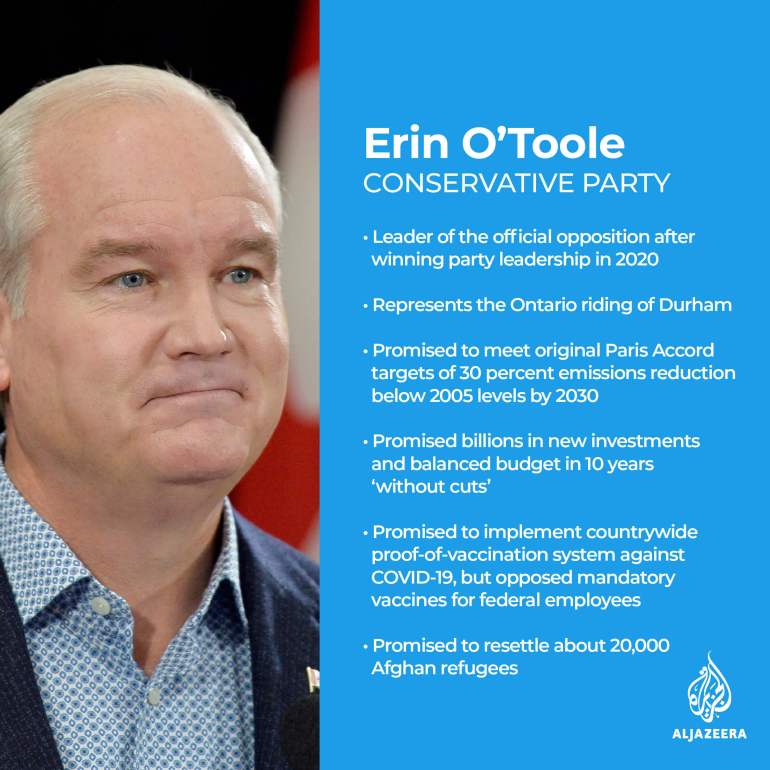 Erin O’Toole won the Conservative Party leadership in 2020 [Al Jazeera]
Erin O’Toole won the Conservative Party leadership in 2020 [Al Jazeera]New Democratic Party
Singh, the first person of colour to lead a federal party in Canada, and his left-leaning New Democratic Party are proposing a $20 minimum wage and 10 days of paid sick leave for all federally regulated workplaces which include, amongst others, airlines, banks and most Crown corporations.
The NDP also has pledged to reduce carbon emissions to 50 percent below 2005 levels by 2030.
Late last month, Singh emerged as the most likeable federal party leader in an Ipsos poll; 45 percent of respondents viewed him favourably, compared with 41 percent for Trudeau, who finished second.
 Jagmeet Singh in 2017 became the first visible minority leader of a federal party in Canada [Al Jazeera]
Jagmeet Singh in 2017 became the first visible minority leader of a federal party in Canada [Al Jazeera]Bloc Quebecois
Yves-Francois Blanchet is the leader of the Bloc Quebecois, a party that only runs candidates in the French-speaking province of Quebec.
Under Blanchet, who represents Beloeil-Chambly, a riding south of Montreal, the party increased its seats in Parliament from 10 to 32 in the last federal election in 2019.
The party says it will introduce a bill making sufficient French-language knowledge a condition for granting Canadian citizenship to immigrants in Quebec, and it has also called for no interference from Ottawa on Quebec laws. That demand comes in light of a controversial provincial law known as Bill 21 that bars some public servants from wearing religious symbols – such as the hijab – while on the job.
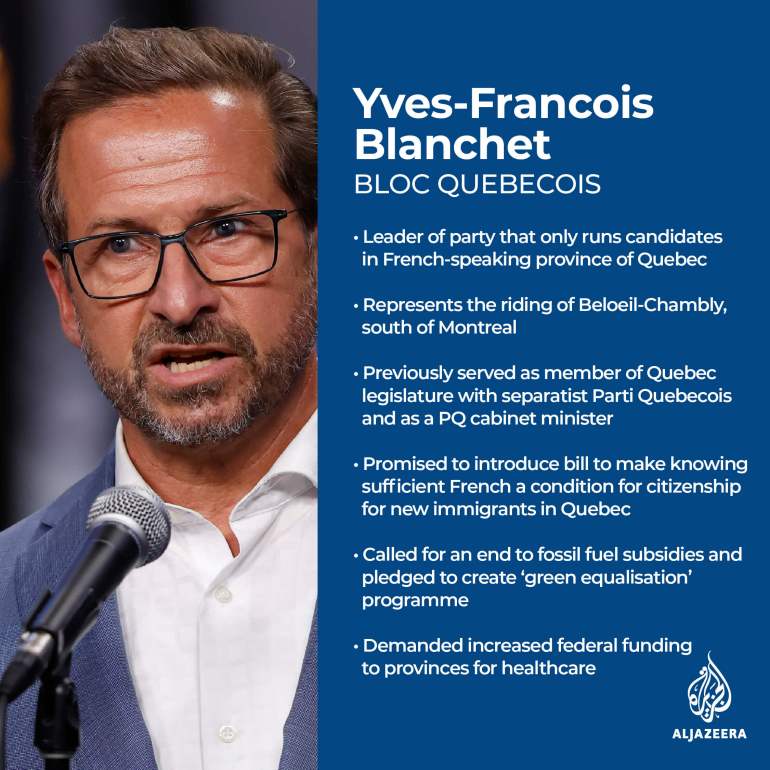 The Bloc Quebec bills itself as the only party to defend Quebec’s interests at the federal level [Al Jazeera]
The Bloc Quebec bills itself as the only party to defend Quebec’s interests at the federal level [Al Jazeera]Green Party
The Green Party won three seats in the last federal election.
Annamie Paul won the party leadership last year but, along with Maxime Bernier, she is one of two federal party leaders who are not members of parliament after she lost a by-election in Toronto Centre in October 2020. She is campaigning for that same seat in this election.
The Greens’ platform primarily focuses on the environment, and the party has pledged to reduce greenhouse gas emissions by 60 percent from 2005 levels by 2030.
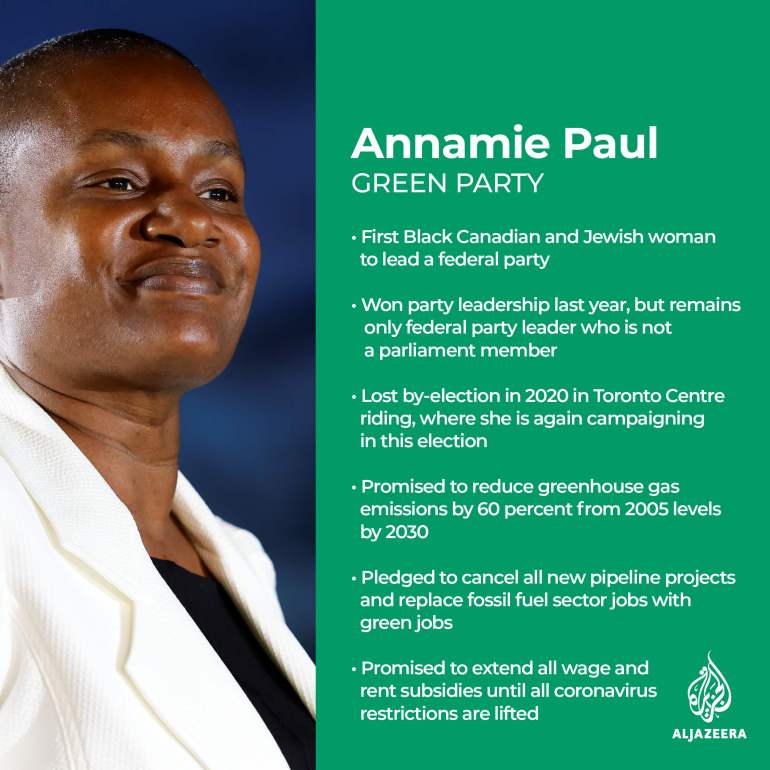 The Green Party has promised to cancel all new pipeline projects in Canada [Al Jazeera]
The Green Party has promised to cancel all new pipeline projects in Canada [Al Jazeera]People’s Party
The far-right People’s Party has no representative in Parliament and got only 1.6 percent of the vote in 2019.
Leader Maxime Bernier formed the party in 2018 after he narrowly lost the Conservative leadership race. Under the PPC banner, Bernier lost his seat in Quebec’s rural Beauce riding, which he had held since 2006, in the last federal election.
The PPC is running on an anti-coronavirus vaccine and anti-immigration platform.
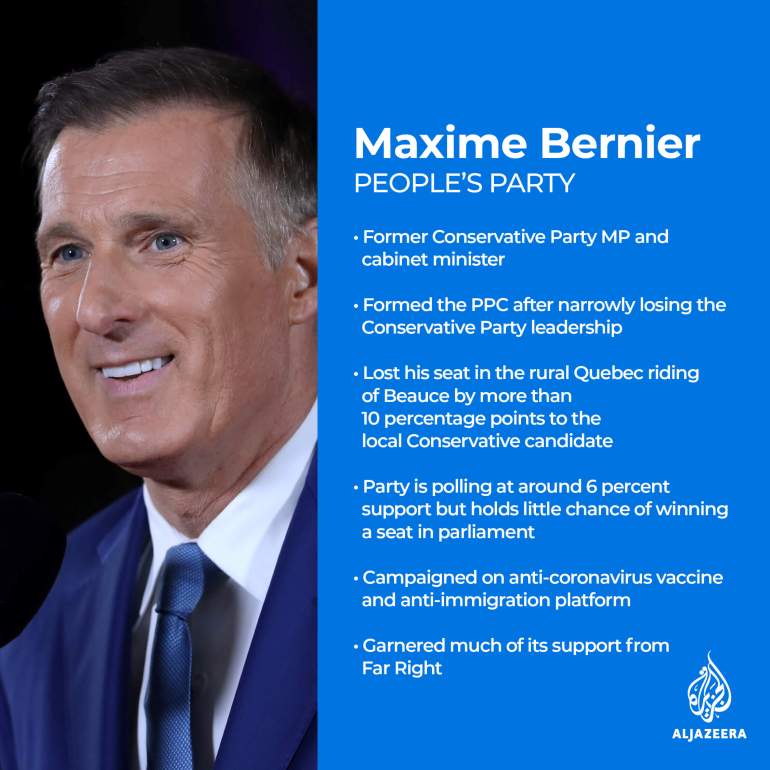 Bernier, a former Conservative MP and cabinet member, formed the PPC after losing the Conservative leadership race in 2017 [Al Jazeera]
Bernier, a former Conservative MP and cabinet member, formed the PPC after losing the Conservative leadership race in 2017 [Al Jazeera]"need" - Google News
September 19, 2021 at 10:13PM
https://ift.tt/3tX03jF
Infographic: All you need to know about the Canadian election - Al Jazeera English
"need" - Google News
https://ift.tt/3c23wne
https://ift.tt/2YsHiXz
Bagikan Berita Ini















0 Response to "Infographic: All you need to know about the Canadian election - Al Jazeera English"
Post a Comment